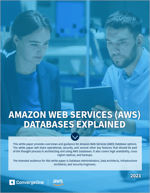AWS (Amazon Web Services) Databases Explained
Posted by C1 on Jul 6, 2021 10:00:00 AM
Over the years, we have seen a shift from the concept of traditional IT, where a relational database was used for everything, to the public cloud. As the rate of generation and the demand for data continues to grow at an exponential rate, many businesses now face the challenge of not knowing how to cope with the rapid changes while having so much data at their disposal. Users that once dealt with Gigabytes (GBs) of data find themselves now having to learn how to work with Petabytes (PBs). This goes to show that in order for businesses to continue to excel, they need to remain proactive and evolve along with the ever-changing world of technology.
In today’s world, it is common to use a broad range of databases to cater to each aspect of a business.
Amazon Database Types
AWS consists of multiple fully managed database services, each built for its unique purpose (see the table below). As data continues to become an organization’s most valuable asset, the amount of data also increases exponentially, creating newer and bigger challenges for businesses today. This means that we can no longer use a one-size-fits-all solution.
New data demands from organizations:
- Ability to store PBs of data
- Sub-millisecond latency requirements for global users
- Management of millions of requests per second
- Online leaderboards in real-time driving analytics
How to Choose the Right Database
Customers often ask me, “What database is right for my business?” This is a tricky question to answer on the spot, because the reality is that there is no one database in the cloud that does it all. We usually see a mix of databases across an organization.
When choosing a database, we have to evaluate several aspects, such as users, security, and data. Here are some starter questions to kick-start the evaluation process:
- What kind of data are we storing? Structured, semi-structured, or unstructured?
- What is the amount of data to store? What is the object size?
- What is the duration of storage?
- Is it read/write heavy or balanced?
- What are the latency requirements?
- What type of schema? Strong or flexible?
- What is the RTO/RPO for DR?
- How many concurrent users?
[WHITE PAPER]
WHAT DATABASE IS RIGHT FOR YOUR BUSINESS?

This ConvergeOne white paper provides overviews and guidance for Amazon Web Services (AWS) Database options. It shares operational, security, and several other key features that should be part of the thought process in architecting and using AWS Databases. It also covers high availability, cross region replicas, and backups.
Topics: Cloud, Data Center, Cloud Infrastructure



